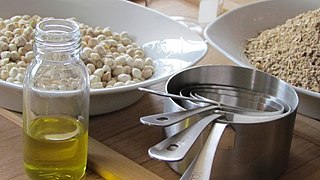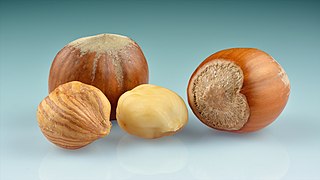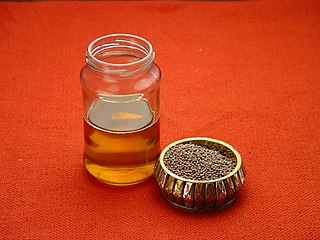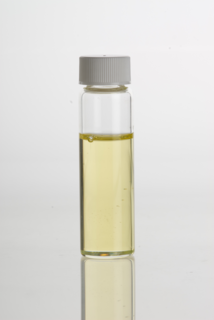 W
WCooking oil is plant, animal, or synthetic fat used in frying, baking, and other types of cooking. It is also used in food preparation and flavoring not involving heat, such as salad dressings and bread dippings like bread dips, and may be called edible oil.
 W
WAçaí oil is obtained from the fruit of Euterpe oleracea, which grows in the Amazon rainforest. The oil is rich in phenolic compounds similar in profile to the pulp itself, such as vanillic acid, syringic acid, p-hydroxybenzoic acid, protocatechuic acid and ferulic acid as well as (+)-catechin and numerous procyanidin oligomers.
 W
WAmaranth oil is extracted from the seeds of two species of the genus Amaranthus — A. cruentus and A. hypochondriacus — that are called, collectively, amaranth grain.
 W
WApple seed oil is a vegetable oil obtained by pressing apple seeds. It is used in manufacturing cosmetics.
 W
WArgan oil is a plant oil produced from the kernels of the argan tree that is endemic to Morocco. In Morocco, argan oil is used to dip bread in at breakfast or to drizzle on couscous or pasta. It is also used for cosmetic purposes.
 W
WBabassu oil or cusi oil is a clear light yellow vegetable oil extracted from the seeds of the babassu palm which grows in the Amazon region of South America. It is a non-drying oil used in food, cleaners and skin products. This oil has properties similar to coconut oil and is used in much the same context. It is increasingly being used as a substitute for coconut oil. Babassu oil is about 70% lipids, in the following proportions:
 W
WBen oil is pressed from the seeds of the Moringa oleifera, known variously as the horseradish tree, ben oil tree, or drumstick tree. The oil is characterized by an unusually long shelf life and a mild, but pleasant taste. The name of the oil is derived from the presence of behenic acid. The oil's components are:
 W
WBertolli is a Spanish-owned brand of Italian food products. Originating as a brand of extra-virgin olive oil, in which it was the global market leader, pasta sauces and ready meals are now sold under the brand name as well.
 W
WCoconut oil is an edible oil derived from the wick, meat, and milk of the coconut palm fruit. Coconut oil is a white solid fat, melting at warmer room temperatures of around 25 °C (78 °F), in warmer climates during the summer months it is a clear thin liquid oil. Unrefined varieties have a distinct coconut aroma. It is used as a food oil, and in industrial applications for cosmetics and detergent production. Due to its high levels of saturated fat, numerous health authorities recommend limiting its consumption as a food.
 W
WCorn oil is oil extracted from the germ of corn (maize). Its main use is in cooking, where its high smoke point makes refined corn oil a valuable frying oil. It is also a key ingredient in some margarines. Corn oil is generally less expensive than most other types of vegetable oils.
 W
WCottonseed oil is cooking oil from the seeds of cotton plants of various species, mainly Gossypium hirsutum and Gossypium herbaceum, that are grown for cotton fiber, animal feed, and oil.
 W
WDalda is a brand of vegetable ghee popular in South Asia.
 W
WGrape seed oil is a vegetable oil derived from the seeds of grapes. A by-product of the winemaking industry, it is typically used for edible applications.
 W
WThe hazelnut is the fruit of the hazel and therefore includes any of the nuts deriving from species of the genus Corylus, especially the nuts of the species Corylus avellana. They are also known as cobnuts or filberts according to species. A cob is roughly spherical to oval, about 15–25 mm long and 10–15 mm in diameter, with an outer fibrous husk surrounding a smooth shell and a filbert is more elongated, being about twice as long as its diameter. The nut falls out of the husk when ripe, about seven to eight months after pollination. The kernel of the seed is edible and used raw or roasted, or ground into a paste. The seed has a thin, dark brown skin, which is sometimes removed before cooking.
 W
WMacadamia oil is the non-volatile oil collected from the nuts of the macadamia, a native Australian plant. It is used in food as a frying or salad oil, and in cosmetic formulations as an emollient or fragrance fixative.
 W
WMarula oil is extracted from the kernels (nuts) of the fruits of the Marula trees, from the family Anacardiaceae. There are two types of marula oil, the oil extracted from the seeds and the oil extracted from the nut's hard shell. Marula oil is traditionally used in cosmetics, in food as a cooking oil, and as a meat preservative and to treat leather.
 W
WMustard oil can mean either the pressed oil used for cooking, or a pungent essential oil also known as volatile oil of mustard. The essential oil results from grinding mustard seed, mixing the grounds with water, and extracting the resulting volatile oil by distillation. It can also be produced by dry distillation of the seed. Pressed mustard oil is used as cooking oil in some cultures, but sale is restricted in some countries due to high levels of erucic acid. Varieties of mustard seed also exist that are low in erucic acid.
 W
WOlive oil is a liquid fat obtained from olives, a traditional tree crop of the Mediterranean Basin, produced by pressing whole olives and extracting the oil. It is commonly used in cooking, for frying foods or as a salad dressing. It is also used in cosmetics, pharmaceuticals, and soaps, and as a fuel for traditional oil lamps, and has additional uses in some religions. The olive is one of three core food plants in Mediterranean cuisine; the other two are wheat and grapes. Olive trees have been grown around the Mediterranean since the 8th millennium BC.
 W
WPAM is a cooking spray currently owned and distributed by ConAgra Foods. Its main ingredient is canola oil.
 W
WPeanut oil, also known as groundnut oil or arachis oil, is a vegetable oil derived from peanuts. The oil usually has a mild or neutral flavor but, if made with roasted peanuts, has a stronger peanut flavor and aroma. It is often used in American, Chinese, Indian, African and Southeast Asian cuisine, both for general cooking, and in the case of roasted oil, for added flavor.
 W
WPerilla oil is an edible vegetable oil derived from perilla seeds. Having a distinct nutty aroma and taste, the oil pressed from the toasted perilla seeds is used as a flavor enhancer, condiment, and cooking oil in Korean cuisine. The oil pressed from untoasted perilla seeds is used for non-culinary purposes.
 W
WPumpkin seed oil is a culinary oil, used especially in central Europe.
 W
WRice bran oil is the oil extracted from the hard outer brown layer of rice called chaff. It is known for its high smoke point of 232 °C (450 °F) and mild flavor, making it suitable for high-temperature cooking methods such as stir frying and deep frying. It is popular as a cooking oil in the Indian subcontinent and East Asian countries, including India, Nepal, Bangladesh, Indonesia, Japan, and Malaysia.
 W
WSafflower, Carthamus tinctorius, is a highly branched, herbaceous, thistle-like annual plant in the sunflower family Asteraceae. It is commercially cultivated for vegetable oil extracted from the seeds and was used by the early Spanish colonies along the Rio Grande as a substitute for saffron. Plants are 30 to 150 cm tall with globular flower heads having yellow, orange, or red flowers. Each branch will usually have from one to five flower heads containing 15 to 20 seeds per head. Safflower is native to arid environments having seasonal rain. It grows a deep taproot which enables it to thrive in such environments.
 W
WSafflower, Carthamus tinctorius, is a highly branched, herbaceous, thistle-like annual plant in the sunflower family Asteraceae. It is commercially cultivated for vegetable oil extracted from the seeds and was used by the early Spanish colonies along the Rio Grande as a substitute for saffron. Plants are 30 to 150 cm tall with globular flower heads having yellow, orange, or red flowers. Each branch will usually have from one to five flower heads containing 15 to 20 seeds per head. Safflower is native to arid environments having seasonal rain. It grows a deep taproot which enables it to thrive in such environments.
 W
WSesame oil is an edible vegetable oil derived from sesame seeds. Besides being used as a cooking oil, it is used as a flavor enhancer in many cuisines, having a distinctive nutty aroma and taste. The oil is one of the earliest-known crop-based oils. Worldwide mass modern production is limited due to the inefficient manual harvesting process required to extract the oil. Sesame, in the Akkadian language and in Tamil it is called Ell (எள்). and chamke(참깨) in korean.
 W
WShorea robusta seed oil is an edible oil extracted from the seeds of Shorea robusta. Shorea robusta is known as the Sal tree in India. Sal is indigenous to India and occurs in two main regions separated by the Gangetic Plain, namely the northern and central Indian regions. The plant belongs to the Dipterocarpaceae botanical family.
 W
WSmen is a salted, fermented butter, and a traditional Yemeni dish. In Yemen, Yemenis prepare a special version of semneh (سمنة) which is smoked with aromatic herbs inside of a gourd in order to impart deeper flavour and aid in preservation. However, smen is also an important ingredient in Middle Eastern cuisine and North African cooking. It is produced using the butter made from the milk of sheep, goats or a combination of the two. The butter is brought to its boiling point for about 15 minutes, then skimmed, strained into a ceramic jar called a khabia, and salted before it curdles. Some have it as a practice to add roasted fenugreek seeds to the boiling butter, after which it is strained from the fenugreek seeds. Thyme is often added to it to provide a yeast and enzyme starter. Other plants or fruits can be used. The result is then aged, often in sealed containers. It is then traditionally buried in the ground for temperature stability purposes, just like cheese is left to mature in caves because they have cooler and more stable temperatures.
 W
WSunflower oil is the non-volatile oil pressed from the seeds of sunflower. Sunflower oil is commonly used in food as a frying oil, and in cosmetic formulations as an emollient.
 W
WTea seed oil is an edible plant oil. It is obtained from the seeds of Camellia oleifera.
 W
WTruffle oil is a modern culinary ingredient used to impart the flavor and aroma of truffles to a dish. The ingredient is commonly used as a finishing oil in a variety of dishes, including truffle fries, pasta dishes, pizzas, and puréed foods such as mashed potatoes and deviled eggs. Truffle oil is available in all seasons and is significantly less expensive than fresh truffles. This has also led to a market growth in the product and an increase in the availability of truffle-flavored foods.
 W
WVirola surinamensis, known commonly as baboonwood, ucuuba, ucuhuba and chalviande, is a species of flowering plant in the family Myristicaceae. It is found in Brazil, Costa Rica, Ecuador, French Guiana, Guyana, Panama, Peru, Suriname, and Venezuela. It has also been naturalized in the Caribbean. Its natural habitats are subtropical or tropical moist lowland forests, subtropical or tropical swamps, and heavily degraded former forest. Although the species is listed as threatened due to habitat loss by the IUCN, it is a common tree species found throughout Central and South America.